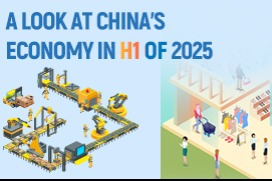Rate alarms shouldn't influence monetary moves


A worldwide trend of tightening monetary policy has been quite noticeable, which is best represented by the US Federal Reserve's latest moves. This will definitely affect global capital flows, risk appetite and asset pricing. China's economy and monetary policy thus face challenges.
There is solid evidence that the US-China interest rate difference is not the major element affecting China's cross-border capital flows. Even in an empirical regression model that includes external financial cyclical factors, an external financial cycle's impact on cross-border capital flows is less than expected.
This can be largely attributed to the unique environment, the nature of market participants and motives behind China's capital flow. China's capital account sees foreign companies and import-export firms, rather than residents or financial investors, exert a greater influence on short-term capital flows.
China's short-term capital flows are determined more by factors such as balance of payments, deposits of trading firms, loans, trade financing and financial leases. Changes in interest rate differences exert a limited impact, especially when compared to financial investors.
Empirical research shows that exchange rate expectations represent the predominant factor affecting China's short-term capital flows. The reason for this is the gradual reform in setting the renminbi's foreign exchange rate, under which the currency has maintained expectations of unilateral appreciation or depreciation for a long time.
The renminbi saw a gradual appreciation against the US dollar from 2005 to 2015, except for the re-peg to the greenback during the global financial crisis from late 2008 to early 2010. Expectations of the renminbi's unilateral appreciation existed in the foreign exchange market most of the time. The pressure on net capital inflows was relatively higher during the decade.
The renminbi experienced unilateral depreciation pressure between 2015 and 2017. The pressure on net capital outflows was higher.
The renminbi has become more flexible in terms of foreign exchange proceedings since 2017, which has resulted in weaker expectations in unilateral changes in the exchange rate and more balanced cross-border capital flows.
Chinese monetary regulators have not intervened in the foreign exchange reserve market since 2017, and they announced in 2020 a fadeout of the "counter-cyclical factor "used in the quotation model for the renminbi-US dollar parity rate. The renminbi's foreign exchange rate is more market-oriented, with supply and demand more balanced. Expectations of the renminbi's unilateral fluctuation have been lowered and cross-border capital flows thus stabilized.
The strength of the Chinese economy is another major factor influencing cross-border capital flows. When the economy outperforms, companies' robust capital demand will be translated into increased capital inflows. Short-term capital inflows decrease when the economy underperforms.
Differing from most developed countries where inflation is the biggest problem at present, China's major challenge at present is a low potential GDP growth rate and an underperforming economy.
China's potential GDP growth rate is mainly restricted in three aspects.
First, the resurgence of COVID-19 places pressure on economic recovery, especially in the services industry and the job market.
Second, real estate is challenged by long-term adjustments and short-term liquidity shortages. Housing sales and investment will undoubtedly slow. The country's overall credit expansion will be affected.
Third, exports' contribution to economic growth has contracted, which is inevitable due to the slowdown of global economic growth and high base readings over the past few years.
Therefore, the focus should be diverted to avoid an excessive economic slowdown, which may result in the emergence of some potential risks in the short run. Structural problems will be more prominent and it will be more difficult to prevent and defuse major risks under such circumstances.
China should thus adopt a more powerful combination of macroeconomic policies to revitalize the economy. Instead of overly relying on local government financing platforms, there should be more extensive application of regulated interest rate policies, fiscal policies and policy-based financial tools so that China can realize economic growth while avoiding any rippling effect of inappropriate policies.
China's monetary policy should be centered on boosting domestic demand. There is no need to worry about the influence of the expanded China-US interest rate difference on capital flows.
China may face pressure from capital outflows and renminbi depreciation this year due to Fed rate hikes and China's economic downtrend. Past experience shows that capital flows tend to stabilize when there is little market intervention, as the country's foreign exchange formation mechanism is now more market-oriented.
Even if the renminbi depreciates to some degree this year, it is not totally negative, as it may help boost demand and, on the contrary, drive economic growth. China's stronger competitiveness in terms of exports will prevent the renminbi from further slides.
By sticking to the market-oriented foreign exchange formation mechanism, plans should be prepared for countercyclical cross-border capital flows under special scenarios to prevent speculative capital flows.
Monetary regulators should clarify interest rate adjustment trajectories so that the market can see the government's commitment to stabilizing growth. A possible solution is to lower the policy rate by 25 basis points under each phase and the lowering steps should not be held up until the growth target is realized.
The lowered policy rate can help expand credit by reducing the cost of debt, increasing asset valuation and strengthening the balance sheet. The debt of the Chinese government, companies and residents reached 73 trillion yuan ($11 trillion), 171 trillion yuan and 67 trillion yuan, respectively, in the first half of 2021. Lowering the policy rate by 100 basis points can reduce 3 trillion yuan in interest rate payments with regard to debts. This will play an important role in supporting investment and boosting consumption.
Meanwhile, policy rate adjustments can guide market expectations and help policies better function for market entities, creating stronger combined force to stabilize growth. More importantly, policy interest rates can be adjusted flexibly and in a timely fashion.
Monetary policy is effective only when financing costs are lowered. The phase of lowering interest rates should not be decided by other countries or based on past experience. The current economic situation is the only gauge needed. When companies are willing to spend and residents willing to borrow, monetary policy can be defined as effective.
China has ample room to make monetary policy adjustments. Monetary policies adopted by other countries after global financial crises showed that there was much bigger policy room than we had imagined. Chinese monetary authorities can develop more tools to lower financing costs for companies and residents to stimulate investment and consumption. The overall economy will be vitalized.
China's nominal interest rate is way above zero. Even for Japan and other European countries whose economic outlook is much weaker, they still have room to adjust their monetary policies. China should therefore not overly worry about the issue.
The writer is a senior researcher with the China Finance 40 Forum, a Chinese think tank. The article is a translated version of an op-ed by the writer, which first went online on the Forum's official WeChat account.
The views don't necessarily reflect those of China Daily.




































